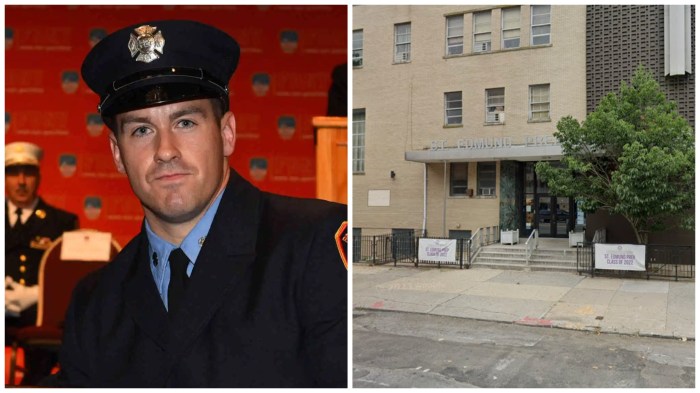By Charles Komanoff
Another week, another dead cyclist. Last Friday evening, 27-year-old Eugenio Cidron left a party at Chelsea Piers, steered his silver BMW onto the no-cars-allowed Hudson River Greenway and drove south for a mile — a mile! — until he smashed head-on into 22-year-old Eric Ng just north of Houston St., killing him instantly.
Six months ago, physician Henry Nacht was killed on the same “greenway” when a police tow truck driver plowed through a “Yield to Bikes and Peds” sign and struck him broadside. Dr. Nacht lived a little longer than Eric Ng — he was kept on life support so his grown kids could fly in to say goodbye, then allowed to die.
Everyone who rides in New York dies a little when a cyclist is killed. But these two deaths, on what had been considered a safe haven from car-crazed streets, are especially shattering. Several times this year my wife and I and our two school-age sons have ridden home on the greenway on Friday evenings, just like Eric. As a fellow cyclist wrote on Streetsblog, “How many parents will think twice before taking a child on the path now?”
The crashes that killed Henry and Eric weren’t “freak” occurrences. To the contrary, they are the predictable result of policy, and specifically of a rooted, stubborn determination on the part of local government, from the mayor on down, to enable and encourage driving as much as possible, and a corresponding reluctance to take back from drivers any space now available to them.
Let’s start with Mr. Cidron. Local cycling blogs have fixated on press reports that the driver was drunk and on speculation that bollards intended to keep out motor vehicles had been removed. Irrelevant nonsense. It defies credulity that the driver, who lived a short hop away, in the East Village, was too soused, or the pavement configuration was too vague, for him to realize he had stumbled onto a bike path. No, most likely Mr. Cidron was on a joyride, with alcohol as enabler, not confuser. What was he thinking? Wow, my own personal road, this is wild! Bicyclist up ahead? Out of my way, buddy, I’m driving here.
As for Eric: The greenway is just six-and-a-half feet wide on either side, leaving little room to dodge a speeding and possibly weaving, six-foot-wide automobile. But even without rogue BMWs, the path has been too narrow from day one. State and city planners blandly call the Greenway a victim of its own success, but it’s not. It’s a victim of their parsimony in acknowledging and accommodating the obviously significant demand for non-motor locomotion. Their refusal to appropriate one of the many car lanes from the enormous adjacent highway has consigned thousands of non-motorized users to a grossly inadequate ribbon of pavement.
Consider the markers in Eric Ng’s short life: New York City Teaching Fellow … teacher in a Brooklyn vocational school … volunteer with Time’s Up. And we lost him, quite unnecessarily, because we can’t bring ourselves to attack the culture of car privilege and driver entitlement. Likewise Carl Henry Nacht, accomplished and brilliant, healer to many, and, like Eric, a devotee of cycling. Much has been made of the fact that Henry’s wife slowed before the crossing while he kept pedaling, but I’ll bet he was scanning the highway for traffic and never imagined that an 8,000-lb vehicle would turn across his path at speed.
We don’t know, in fact, how fast the tow truck was going — the NYPD hasn’t said — but 40 mph is probably a conservative figure; Henry was flung into another tow truck parked a dozen feet away. What was the driver thinking? I’m king of the road? Almost quitting time? One thing he clearly wasn’t thinking was this: Greenway crossing, Slow down, Check both ways, Got to look out for late-night joggers and cyclists. With the N.Y.P.D. now into a third year of its demented obsession with the Critical Mass bike rides, and with a car-centric policing culture that situates cyclists somewhere between nuisances and deviants, the tow-truck driver’s evident unconcern toward people on the greenway was no more an accident than Mr. Cidron’s booze-and-Beemer jeu d’esprit.
The mayor could turn this around. He could direct police to enforce traffic laws against drivers’ too-close passing and other bullying that are the biggest causes of fatal cycle crashes. He could muster his vaunted backbone in support of congestion pricing and other traffic-busting policies, and allocate some of the freed street space to cycling.
Don’t hold your breath. The mayor hasn’t even expressed any regret about Eric Ng or Henry Nacht or the dozen other New Yorkers whose lives have been taken this year while they rode bikes in his city. Instead, he seems determined to stay the course in our city’s long-standing, and deadly, War on Cyclists.
Charles Komanoff, who lives in Tribeca, is an economist and member of Time’s Up, a cycling advocacy group.

















